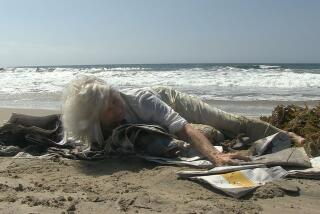Abstract dislocation in a post-9/11 world
- Share via
Among postmodern abstractionists, New York-based dancer-choreographer Stephen Petronio cultivated a distinctively liquid, sensual way of moving that made his formal explorations unexpectedly lush and stylish.
However, after the events of Sept. 11, Petronio switched direction and, in his mid-40s, attempted to force himself into new expressive territory -- an agenda dominating his company’s strongly danced but curiously flat three-part UCLA Live program in Royce Hall on Friday.
Although his irreverence and fondness for masquerade turned up in the doll dances of “The Island of Misfit Toys” (2003), dark energies drove all the pieces; ultimately, the evening became an exercise in finding active, expansive outlets for passive, downbeat feelings.
In his “Broken Man” solo, Petronio kept swirling and melting into postures of pain, with the spare, mournful music of Blixa Bargeld reinforcing his sobbing spasms and angry arm swings that carried the whole body into spins and slumps -- the whole sense of his being on the verge of collapse.
“City of Twist” (2002) represented Petronio’s foray into social portraiture: initially a series of solos for Jimena Paz, Gino Grenek and Gerald Casel in which his dancers seemed to be playing roles and performing variations on the “Broken Man” body language.
The dim, nearly subliminally projected cityscapes by Ken Tabachnick and the numbed-out score by Laurie Anderson sustained an elegiac mood, with only the unpredictable and often puckish costuming by Tara Subkoff helping “City of Twist” avoid succumbing to unrelieved abstract angst.
Ensemble passages featured lots of alignments forming and dissolving, the juxtaposition of gestural activity and full-out dancing, sudden shifts into slow motion and a few instances where Petronio showed people helping one another up, although the effect remained resolutely anti-dramatic.
At the end, however, flashing lights heralded a solo for Ashleigh Leite that was full of fury and despair -- a flailing, keening, body-lashing coda to the work that found Petronio working in primary emotional colors like never before.
And perhaps never again. Certainly, “The Island of Misfit Toys” couched its emotions in irony and restless discontinuity, playing off a whole collection of cryptic Lou Reed tunes and texts, but never achieving anything as intense as the grotesquerie of Cindy Sherman’s giant doll sculptures.
Decapitating two of those dolls provided one anti-climax, the rock dancing to “Waiting for the Man” another, and excursions into jaunty postmodern vaudeville (including a bit of toe-dancing by Shila Tirabassi) introduced a variety of means missing in “City of Twist.”
However, the doll dances arguably proved the most intriguing segment, since they asked Petronio to forsake the miraculous suppleness and loose-limbed flow of his style for a deliberately stiff, unhinged, ricky-tick attack.
Mission accomplished, but the piece’s larger aim -- conveying Petronio’s feeling of not belonging, of being a misfit toy in our wartime millennial culture -- never really made an impact.
He may be right: If postmodernism died Sept. 11, 2001, there may no longer be any real need for his sleek dance-for-dance’s sake diversions.
Or for Mark Morris’ supremely clever music visualizations. Or for all the other exquisite, isolated personal specialties that constitute contemporary American dance. But one might hope for a more powerful statement of dislocation, a more memorable assertion of the kind of art, and artist, that America produced before cataclysm changed everything.
Besides the dancers previously mentioned, the Petronio company included Thang Dao, Elena Demianenko and Amanda Wells.
More to Read
The biggest entertainment stories
Get our big stories about Hollywood, film, television, music, arts, culture and more right in your inbox as soon as they publish.
You may occasionally receive promotional content from the Los Angeles Times.










